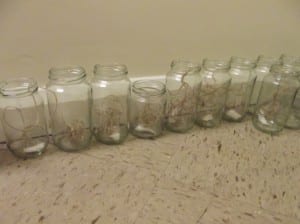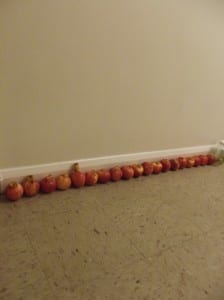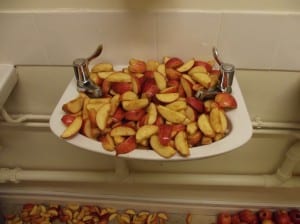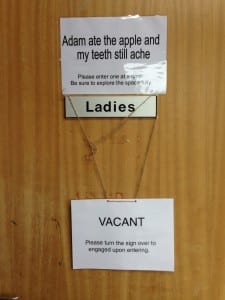The Apples in their Jars – Framing Statement
Adam ate the apple and our teeth still ache was performed at the Grandstand on the 8th May, 2014 by two female performers. The piece was largely influenced by my own personal connection to the Grandstand, as well as its history and involvement in the community. The performance explored the decomposition of the Grandstand as the ‘core’ of a community, considering the past and present inhabitants of the space. We used apples to expose the Grandstands detachment and decay. The idea of apples originated from a gift I brought to the Grandstand; a perfume bottle shaped like an apple. I described how it was the apple a winning horse had bitten out of before winning a race, which, in hindsight created our direct link to the Grandstand itself.
The space itself was the ladies toilets. Access to the space was limited, having to walk through the RAF room and a small corridor to reach the entrance. A 15 minute rota coincided with other performers in the RAF room to ensure us a consistent flow of audience members. Audience members were encouraged to explore the space themselves in their own time. As it was a one to one performance, each performance was different and individual to the spectator. When entering the room, there was a narrow walkway with steps down to the sinks overflowing with apple slices. We lined the walls with jars, creating a pathway for audience members to follow. The left side, lined with apples cores, followed down the steps and round to the left into the toilet cubicle area. Tea lights in jars were then placed after every other jar as the space lacked natural light. There were four toilet cubicles containing a form of media. In the first, a speaker played Don’t sit under the apple tree by the Andrews Sisters. The second was plastered with images of my teeth, pictures of a set of teeth with the same condition, and horses’ teeth. The third had a speaker repeating an audio of a horse eating an apple, and the fourth included myself and the audio spiel Appletite. I was also wearing a cheek retractor and had my hands and feet tied, to physically depict my temptation to eat the apples. After every performance I placed the twine around my hands and feet, and the cotton wool protecting my mouth into jars, creating a compilation of evidence for each performance. The other side of the toilets, lead round to by jars of rotten apples, saw Verity surrounded by piles of holey apples and cores. Each audience member was asked to wash the holey apple, then to help Verity find the correct core to fit the hole.
We performed every 15 minutes, including 15 minute breaks for me to take out the retractor. The average length of each individual performance was 5 minutes, depending on the cooperation of the audience member. Audience members were encouraged to enter our space on their own accord.
Lingering Tenancies – Analysis of Process
But was it our space they were exploring? These toilets were for public use, a necessity within a communal building that many visitors would have used. As for the Grandstand itself, it had been inhabited by many others before us. So was it fair to claim it as ours? These kinds of questions really influenced our choice of space, and eventually became the sole focus of our performance installation. “Landscapes told as a distribution of stories and dramatic episodes, or as repertoires of lived practice, can be creatively recut, embroidered, and still sustain original narratological integrity” (Lorimer, 2006, 515), thus I began to have in depth thoughts surrounding the term ‘found’ itself. Is the site ‘found’ historically/geographically? Is ‘finding’ something an individual experience, or is it a collective effort? Can we argue that inspiration and/or objects ‘found’ on site are actually OURS as previously mentioned? I began to really think about the idea of people creating temporary tenancies in regular everyday life:
If we are, for example, to enter a train and sit down, naturally we allocate ourselves seats. If we then were to leave briefly, and return to find someone else sat in said seat, we claim that the seat is ours and that they are in fact intruding on our ‘site’, as it were. But we all know that the seat doesn’t actually belong to us. Yet this never stops us from setting down temporary roots.
These initial ideas spurred me to research further into previous inhabitants of the Grandstand, curious as to whose roots I was planting myself and my ideas onto.
When wandering around the Grandstand, there are visible remainders of previous ‘tenants’ everywhere. This is either suggested by objects left behind from more recent tenants (Children), or by parts of the building, such as memorials on the wall, from older tenants (RAF). Sadly, “it is possible to be in a place without realising its significance for the groups of people who have historically inhabited it” (Pearson, 2007, 24), so I refused to be ignorant, and delved further into who these tenants may have been, and the stories they have to tell. This research became the substance of our final piece, our need to restore the memories and history back into the life of the Grandstand.
The next step was trying to fill in the empty gaps in the Grandstand, literally. Influenced by Will Dorners Bodies in Urban Spaces (2007), which consisted of dancers using their bodies to fill spaces usually bypassed in everyday life, we looked around for spaces that we could draw attention to. Like Dorner, we used ourselves to fill these neglected ‘spaces’ within the grounds. We eventually came across a rusty, metal fence missing about six of its bars. A fallen down tree had, by chance, placed itself within the gap, almost attempting to fill the void – much like the process we were currently trying to follow. Upon moving inside to continue this exploration of filling a void and planting roots, we found ourselves purposely looking for the signs of decay and neglect within the recently refurbished building, “even when the scene of the crime is pristine we are forced to look at the dirt in the gaps” (Pearson, 2001, 62). We started to (accidentally) delve further into the multifaceted concept of ‘the fallen’ as a result.
We first attempted to photograph a piece of paper falling to the ground. We then discovered a small, high ledge in what seemed to be a neglected bathroom. This bathroom was a lot smaller than our ladies toilets used in the final piece, and it was completely disused. However, it gave us a true insight into just how neglected our performance site would have been before it was refurbished.
As Tuan states, “architectural space reveals and instructs” (1997, 114) and the discovery of this neglected bathroom only reinforced my exploration into the restoration of the Grandstand’s inhabitants. This idea of falling allowed me to research a wider range of material to find inspiration; the definitive fall of a horse in a race, the fear of a soldier falling at war, or merely the fall of a building that was once imperative to a community. A visit to the archives provided me with endless amounts of information on some of these topics, and revealed a lot of new and interesting information about the previous inhabitants of the Grandstand.
On one particular visit to the Grandstand, we were asked to bring the site a gift. I brought in a perfume in the shape of an apple, my thinking being that horses eat apples, and so my gift would nourish the memory of the Grandstand being a race track. I pretended the perfume was in fact the apple a winning horse of the Lincoln handicap had bitten before racing, claiming it was the freshest and juiciest apple of all time. But when thought about logically, the last race was over 50 years ago, so this apple would have deteriorated significantly and would no longer have its own substance. It would be a part of the earth the Grandstand was built on. A building that had, too, began to sink into the earth as it decayed over time.
The idea of having apples at the centre of our performance from then began to take root. Verity and I joined forces, as we were both extremely interested in overwhelming a space with a mass of objects after an extremely insightful trip to the Archives. We were directly influenced by two pieces of information found at the archives: the first was about 5000 leaflets being dropped over Lincoln during WW1 – the vast amount of paper falling from the sky all at once must have been visually incredible to encounter. The second was that the Grandstand had once been considered for the storage of casualties during WW1, acting as a mortuary – we immediately thought of the image portraying the huge pile of shoes left from the victims of Auschwitz. We wanted to recreate a similar image, but through the use of apples.
Verity also mistook what was labelled as the ‘sluicing room’ as the slicing room on the mortuary plans. This small, slightly comedic detail became extremely important within the development of our performance, as we began to discuss ideas of slicing and de-coring apples. Apples have a core that is not eaten, whereas the rest of the apple is gradually eaten away; it serves its purpose, but doesn’t disappear completely. The Grandstand cannot be destroyed because of its pillars. Structurally they are the buildings core, “stag[ing] and fram[ing] those who inhabit its space” (Pearson, 2010, 21). Most hilariously, I am in fact unable to eat apples in their original state. Biting an apple risks me breaking my artificial teeth, therefore the only viable option is for me to slice them. From these two experiences, we quickly learnt that is was extremely important to laugh and “Play around with ideas…[otherwise] when you lose playfulness you lose inspiration” (Dorner, 2005); our most important and creative ideas were a direct result of playfulness.
We then came across a small, cold corridor that led off the RAF room in the Grandstand. One wall was lined with windows, the other with misted glass that looked through into another room. The window frames and wooden panels created a multitude of little ledges. Immediately we could picture these ledges lined with apple cores with tags on, acting almost like storage/shelves. The windows reminded us of a greenhouse, and we could picture jars of progressively rotting apples creating a pathway of decay down the corridor. Just off this corridor are the ladies toilets. After a while we felt that we were limited in ideas of performance in the corridor, so instead though about using it as an installation space. Using the sinks in the bathroom as a production line, we considered the idea of audience members coming in, washing the apples, de-coring them, and placing the core into a jar to add to the collection in the corridor. We then abandoned the corridor completely, deciding to fill the toilets with the apples instead.
Pearson suggests that “performance can provide a mechanism for enacting the intimate connection between personal biographies…and the biography of place” (2011, 2), so we decided to explore how my personal story about my teeth could be embedded in our space. We recorded me talking about my experiences at the dentist (Appletite), then played it from inside a closed cubicle. When writing this piece of text, I began to use words that were apple and horse related to describe my teeth or the process:
“…that was until the cores of my two most visible teeth decided to grow wrong. When I say wrong, I mean they grew through as if I were a baby vampire. From the ages of nine until eleven, I never smiled in pictures, and became reliant on eating with my molars. I found myself more tempted by foods that usually I had no interest in. After numerous trips to the orthodontist, it seemed my only option was to have the pips removed, and tracks of braces to fill in the gaps..”
It was very Moaning Myrtle-esque! We wanted to blur the disciplinary perceptions of a public toilet (Pearson, 2011, 2) by using the privacy associated with toilet cubicles to create an intrusive performance. We loved the idea of the audience having to explore each toilet cubicle, eventually reaching the end one to find me sitting with my teeth exposed whilst Appletite explained my story.
In keeping with wanting an intimate, intrusive performance, we decided to make our piece One to One. Although multiple audience members would have physically been able to fit into the space, we felt that large numbers would diminish the intimacy between the narrative and spectator, creating an exploitation of my personal response to the Grandstand, rather than an inclusion. A One to One experience however would seem more intrusive (physically represented by my space being a toilet cubical); the exposure of my teeth and binding of my hands and feet forcing a personal exposure, whether it is wanted or not. “The potential of One to One performance to enable a shared and intense desire to connect, engage and discover another elucidates something about the ephemeral liveness of what might lure us toward this close encounter” (Zerihan, 2009, p.4). Thus audience members had free will upon entering the site, encouraged by audios to ‘find’ me within the installation, with the choice to stay or not entirely down to them.
“One to One performances feel personal, and if we commit ourselves to them, they can affect us in a myriad of ways” (Zerihan, 2009, 3), especially when the performance pushes “the expressive capabilities and capacities of [its performers] body” (Pearson, 2010, 172).
In Mike Pearson’s In Comes I he states that there was no attempt to either emphasise previous functions of the building or to re-enact moments from its history when creating the performance Baroque (2001), and that the church’s architecture and atmosphere were revealed by what was brought to it (Pearson, 2006, 79). This creative process is similar to ours. We did not explore themes that explicitly relate to the Grandstand and its past inhabitants, but imported an idea (apples) that alludes to such context: horses eat apples → when apples are eaten their core (Grandstand) remains → exposure of the apple’s core results in faster decomposition (neglect). Without our site however, this set-up would become insignificant.
My teeth still ache – Performance Evaluation
Our final performance was physically and emotionally exhausting, although an amazing insight into performance art as opposed to acting. Our audience entered one at a time following instructions on the door, and were asked to turn the sign to ‘engaged’ to ensure it was a personal performance.
We were unsure at times whether the sign was being used, however if it was not, the audience members still waited patiently outside. We performed on a fifteen minute rota, with about five audience members per slot. Towards the end, groups were invited in, due to time constraints, so there were considerably more audience members in a given time slot. On entering the space, audience members were confronted with rows of jars and sinks overflowing with apples as originally planned. Although effective, with audience members gasping at the amount of apples, we would have loved to have had a larger mass of apples and apple cores in jars. Initially we wanted to have two rows of jars on either side of the walkway: one side all rotten apples, symbolising the decay of the grandstand and its status in the community, the other side, apple cores that signified the remains and the exposure of the listed building. However, with only two sets of hands it was difficult to prepare anything larger than what we achieved on the performance day. The sinks did, however, successfully overflow with apple slices. It would have been nice to have had more tea lights to light the space, maybe one every other jar all around the space to make the pathway of jars and their content more visible.
There were a variety of different reactions to both myself and Verity’s performances. Sat in the end toilet cubicle in the dark, surrounded by tea lights and wearing a cheek retractor whilst restrained created quite an ominous atmosphere. Audience members were shocked upon discovering me, most physically jumped at the sight. One audience member burst into laughter, then came back to laugh again. I expected a variety of reactions, nervous laughter maybe, but not hysterical! The reactions were, however really rewarding. It confirmed we had successfully created a foreboding atmosphere, much like how we felt upon discovering abandoned, decomposing rooms in the Grandstand. On the other hand, Verity received a more positive response to her performance. Audience members were very cooperative. One person did in fact start to help her search through the pile of cores, eager to reunite the substance of the apple with its centre. This reaction was particularly ironic, as the audience members themselves were acting then as the Grandstand’s substance, filling the empty core with their presence.
As our performance relied heavily on preparation, it is difficult to say what I as a performer would do differently if I were to perform again. The experience as a whole has however encouraged a more simplistic approach to performance and has opened my mind to the impact a site can have upon theatre. It is easy to forget the site in which you perform in. Yet when the site becomes the drama, performance gains more substance. The walls exude history and memories individual to each audience member, thus creating a a piece of art personal to all involved.
Word Count: 3000
Bibliography
Dorner, W. (2007) Bodies in Urban Spaces. [performance] 4 July.
Dorner, W. (2005) In: Pinchbeck, M. (2014) ‘Site Specific Peformance, Week 2: Practice’. Lecture, Seminar Room MB1008, Lincoln: University of Lincoln. 6 February.
Lorimer, H. (2006) Herding memories of humans and animals. Environment and Planning D:Society and Space.
Pearson, M (2010) Site specific performance. Basingstoke: Palgrave Macmillan.
Pearson, M. (2006) White House Yard. In Comes I: Performance, Memory and Landscape. Exeter:University of Exeter Press.
Pearson, M. (2011) Why Performance? [pdf] Available at: <http://www.landscape.ac.uk/landscape/impactfellowship/peforminggeographieswarplands/toolkit.aspx> [accessed 26 April 2014]
Pearson, M. and Shanks, M. (2001) Theatre Archaeology. London:Routledge.
Tuan, Y. (1997) Space and the place: The perspective of experience. In: Govan, E. Nicholson, H. and Normingtonm, K.(2007) Making a Performance. Coxon:Routledge.
Zerihan, R. (2009) Introduction. Study Room Guide: One to one performance.










